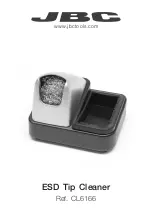
20V max* LIThIUM-ION CORdLeSS hIgh-TORqUe IMpACT wReNCh - 054-3176-6
20V max* LIThIUM-ION CORdLeSS hIgh-TORqUe IMpACT wReNCh - 054-3176-6
13
14
impacting tips
The proper fastening torque may differ depending on the type or size of the bolt, the material of the
workpiece to be fastened, etc.
NOTICE:
hold the tool straight along the axis of the bolt or nut.
NOTICE:
excessive fastening torque may damage the bolt/nut or socket. Before starting your job,
always perform a test operation to determine the proper fastening time for your bolt or nut.
practice with various fasteners, noting the length of time required to reach the desired torque. Check
the tightness with a hand-torque wrench. If the fasteners are too tight, reduce the impacting time. If
they are not tight enough, increase the impacting time.
hold the tool firmly, and place the socket over the bolt or nut. Turn the tool on, and fasten the bolt or nut
to the proper torque.
The torque that is required to loosen a fastener averages 75% to 80% of the tightening torque,
depending on the condition of the contacting surfaces. however, if rust or corrosion causes seizing,
more torque may be required.
After fastening, always check the torque with a torque wrench. The fastening torque is affected by a
wide variety of factors, including the following:
• Voltage:
A voltage reduction will cause a reduction in the fastening torque.
• Socket
: Failure to use the correct size socket will cause a reduction in the fastening torque. A worn
socket (wear on the hex end or square end) will cause a reduction in the fastening torque.
• Bolt
: Although the torque coefficient and the class of bolt may be the same, the proper fastening
torque will differ according to the diameter of the bolt. even if the diameters of bolts are the same,
the proper fastening torque will differ according to the torque coefficient, the class of bolt and the
bolt length.
•
The use of a universal joint or an extension bar (both available separately) will reduce the fastening
force of the impact wrench somewhat. Compensate by fastening for a longer period of time.
•
The manner of holding the tool or the material to be fastened will affect the torque.
opera
ting
instr
uC
tions
installing fasteners
NOTICE:
Always keep the impact wrench at a right angle to the fastener to avoid damaging the
fastener head.
TO FASTEN
1. Start threading the fastener by hand onto or into its threaded counterpart (e.g. nut onto bolt, or bolt
into nut or threaded hole).
2. with the proper impact socket securely mounted to the wrench, slide the impact socket onto the nut
or bolt head.
3. place the direction-of-rotation selector in the FORwARd position, firmly hold the tool and depress
the switch. The impact socket will turn the fastener and impacting will begin once the fastener
encounters resistance.
WARNING!
do not over-tighten, as the force of the impact wrench can break the fastener.
TO lOOSEN
1. with the proper impact socket securely mounted to the wrench, slide the impact socket onto the bolt
head.
2. place the direction- of-rotation selector in the ReVeRSe position, firmly hold the tool and depress the
switch. The tool will start to impact immediately.
3. Once the fastener has “broken loose,” it will start to unthread. Be careful that you do not allow
a fastener to spin freely once it is no longer engaged with its threaded counterpart, as it may be
thrown out of the socket.
opera
ting
instr
uC
tions






























